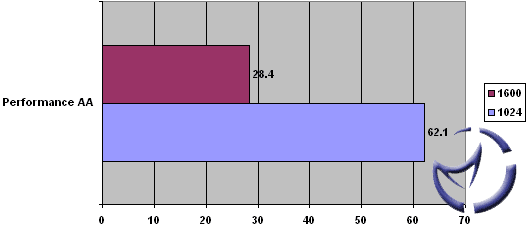|
3D Mark 2001SE
I decided to start things off with a bit of nostalgia, and run the AiW VE through some 3DMark2k1. Truth is, the main reason I kept this benchmark around for one last hurrah is the fact that the GPU is a little long in tooth, so we may as well see where it stands.

Unreal Tournament 2003
Unlike the Futuremark benchmarks, UT2k3 is a real world benchmark that will give you a better representation of what kind of performance you can expect from a title available on store shelves now. We used the , and ran the Antalus and Inferno benchmarks at Low Quality mode. The higher quality modes did run, but results were omitted. If you really need to see graphs of single digit framerates, let me know…
Antalus - Low Quality

Inferno - Low Quality

Serious Sam 2: Second Encounter
Serious Sam was designed with very detailed graphics and still manages to test the capabilities of a video card. I do find some of the textures a bit blocky, but the game engine still stresses modern video cards pretty hard.

I don't think I need to say anything that isn't already obvious from the charts above. Simply put, the AiW VE does have some horsepower, but only when you compare it to the integrated video card market that ATi is targeting.
Quake 3: Arena
This benchmark is older than the GPU used for the VE itself, and although we're planning to retire it shortly, I've added it to test the AntiAliasing performance of the VE. There are two options available, Quality AA and Performance AA. Tests were done at 4xAA.
Quake 3: Arena - Performance 4xAA

Quake 3: Arena - Performance 4xAA

Naturally, quality AA takes a bigger hit than performance. It could be old age, but I found little difference in the quality, so if you do plan on playing with AA on, I'd go for performance. That being said, if you're going to go the AA route, you'll probably have to consider 800x600. Keep in mind that these benchmarks are averages, so realistically, expect severe framerate hits when playing on a loaded server.
Image Quality

Test Picture (reduced quality)
Image quality has always been a subjective thing, but for the sake of at least giving my opinion, we loaded up a 1600x1200 image David used in his last couple of video card reviews. I also pulled up several word documents with various sized fonts to judge the text rendering. The documents used white text on a black background, and vice versa. The screen resolution for all tests was 1600x1200 @ 85Hz on a Dell rebranded 21" Trinitron.
I've actually gathered a few cards here since I originally wanted to expand my ATi Radeon 9700 Pro review with these test. The scores will be out of 10. Here are my results...
|
|
ATi Radeon 9700
|
AiW VE
|
Asus Ti4400
|
MSI MX440-T8x
|
|
Black Text (12Pt)
|
9
|
8
|
7
|
8
|
|
Black Text (6Pt)
|
8
|
8
|
6
|
6
|
|
White Text (12Pt)
|
9
|
9
|
7
|
7
|
|
White Text (6Pt)
|
8
|
8
|
6
|
4
|
|
Bitmap Quality
|
9
|
9
|
8
|
7
|
You're going to have to be aware that these tests are subjective, but I did have my cousin over to help me debate the scores, and the numbers you see above is the average score between two people.
Both ATi cards looked pretty much the same to me, but there is an obvious quality drop when moving to the nVidia solutions. The Ti4400 is passable, but it was eye-straining to work on the PC at extended periods of time at 1600x1200. The MX440 rendered white text on a dark background horribly, and in order not to lose my eyesight, I had to use the mouse to select blocks of text I wanted to read.
|



